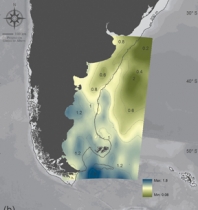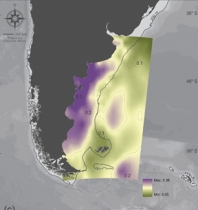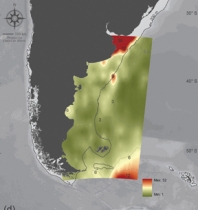|
 |
 | Rio de la Plata estuary. The continental discharge of nutrients (mainly silicates) generates a high productivity frontal zone in the north of the Patagonian Sea. Satellite image.  |
 |
Distribution of nitrates in μmol/kg.
Compiled data: Centro Argentino de Datos Oceanográficos, information contributed by A. Piola (SHN-UBA-CONICET, Argentina).
| © J. Descloitres (NASA/GSFC) |
 |
Nitrates |
 Phosphates Phosphates |
Distribution of phosphates in μmol/kg.
Compiled data: Centro Argentino de Datos Oceanográficos, information contributed by A. Piola (SHN-UBA-CONICET, Argentina).
 |  Nitrites Nitrites |
Distribution of nitrites in μmol/kg.
Compiled data: Centro Argentino de Datos Oceanográficos, information contributed by A. Piola (SHN-UBA-CONICET, Argentina).
 Silicates Silicates |
Distribution of silicates en μmol/kg.
Compiled data: Centro Argentino de Datos Oceanográficos, information contributed by A. Piola (SHN-UBA-CONICET, Argentina).
 | |
|
 |
Nutrients
The development of phytoplankton depends on the light and availability of nutrients dissolved in the sea, including nitrates, nitrites, phosphates and silica. The sub-Antarctic waters of the Malvinas Current provide one of the main sources of nutrients in the Patagonian Sea. The entry of nitrates and phosphates into the system is related directly to the contribution made by this current. The source of certain nutrients, such as nitrites, has not been clearly identified. Continental discharge is another potential source of nutrients, such as silicate, which enters the sea via the Río de la Plata, and to a lesser extent in the Malvinas Current.
|

